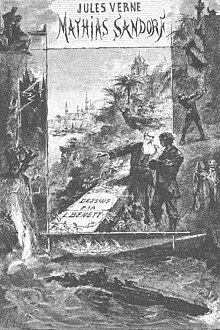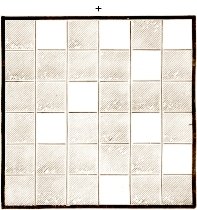Mathias Sandorf


Mathias Sandorf (also Die Rache des Count Sandorf ) is a novel by the French author Jules Verne . The novel was first published in three volumes in 1885 by the publisher Pierre-Jules Hetzel under the French title Mathias Sandorf . Volume I appeared on July 27, 1885, Volume II on August 17, 1885 and Volume III on October 26, 1885. The first German-language edition appeared in 1887 under the title Mathias Sandorf .
action
The action begins in Trieste in 1866 . The destitute crooks Sarcany from Tripoli and Zirone find a carrier pigeon carrying a secret message on one of their walks through the city . Sarcany wants to see if they can capitalize on the embassy. They release the pigeon from a church tower and follow them with their eyes to their dovecote.
This is in a house that belongs to Count Ladislaus Szathmáry , a Hungarian nobleman. Count Szathmáry and his friends, Professor Stefan Báthory and Count Mathias Sandorf , plan to instigate a popular uprising against the rule of Austria in Hungary , their home country . With the help of the Dalmatian banker Silas Toronthal , Sarcany has Count Sandorf, who is staying in Count Szathmáry's house, hired as an accountant. In Count Szathmáry's desk he finds the key template for deciphering the secret message. Sarcany and Toronthal decipher the secret message concerning the planned uprising.
Sarcany and Toronthal denounce the conspiracy. However, they do not act out of “patriotism”, but for material reasons. By treason they want to get fifty percent of the assets of the so-called "high traitors". But only Mathias Sandorf is wealthy, as he has goods and values on a large scale. His property is said to be divided up after his punishment. His daughter Sava should receive the remaining fifty percent of all values after she has reached the age of majority. But after an attack on the Sandorf estate, she is considered missing.
Professor Báthory, Count Sandorf and Count Szathmáry are arrested, taken to a fortress in the mountains of Istria near Pisino and sentenced to death . Through a conversation that they overhear by chance, the prisoners learn that Sarcany has betrayed them. The night before the execution, Count Sandorf and Professor Báthory were able to flee with the help of a lightning rod next to their cell window, the bars of which they could remove along with part of their bed frame. In doing so, they fall into an abyss that lies directly behind their prison. You fall into an underground river that comes to light again by the sea not far from Rovigno on the Adriatic coast . They find shelter at the fisherman Ferrato , but are betrayed again by Carpena , a saltworker. Again they have to flee. Professor Báthory is shot by the police; Count Sandorf has to leave him behind. He can save himself by swimming out on the open sea, probably drowning there. Professor Báthory and Count Szathmáry are executed. Andreas Ferrato is incarcerated and shortly after he dies in prison.
In 1882 a mysterious stranger who calls himself Doctor Antekirtt appears in Ragusa . He takes two French acrobats , the huge Cap Matifou and the slender Pointe Pescade , into his service. Doctor Antekirtt is known that Professor Báthory's widow and his now adult son Pierre as well as the banker Toronthal with his wife and daughter Sava also live in Ragusa.
Pierre Bathory has in Sava Toronthal in love and it's the young man not indifferent. According to her father's will, Sava is supposed to marry Sarcany. Pierre Báthory re-enacts Sarcany, but is brought back to his mother with a knife stab in the chest. It is believed that he tried to commit suicide because he was lovesick. He dies in the presence of Doctor Antekirtt. Later it turns out that Sarcany tried to murder Pierre Báthory. The night after the funeral, Doctor Antekirtt, Cap Matifou and Pointe Pescade go to the cemetery, fetch Pierre Báthory's "corpse" and bring him to the Savarena , Doctor Antekirtt's yacht . There the doctor wakes up the hypnotized Pierre Báthory and gives him his real name: Mathias Sandorf. Antekirtt wants to prevent the relationship between Pierre and Sava, since the son of his dead friend Báthory should not marry the daughter of the traitor Toronthal.
In the further course of the plot, Zirone, who is the leader of the Mafia in Sicily, is thrown into the crater of Etna by Cap Matifou . It turns out that Sava's father is not Silas Toronthal. He took Mathias Sandorf's daughter Sava into his household after betraying him. Doctor Antekirtt brings Toronthal and Carpena under his control to try them on his island of Antekirtta. Sarcany attacks the island with the Senouists influenced by him , who see Antekirtt as an enemy, and is also taken prisoner. The prisoners are sentenced to death and taken to the neighboring island of Kencraf, where they must await the execution of the sentence. Before the death sentences can be carried out, the prisoners are killed in the explosion of land mines whose detonators they accidentally set off. The entire island of Kencraf is destroyed in the explosion of the mines intended to ward off the Senouists. Two days after this disaster, Sava Sandorf and Pierre Báthory marry. Mathias Sandorf could return to his Hungarian homeland as a result of a general amnesty for political crimes, but prefers to remain Chairman of the Council of Antekirtta and become president of an association of expellees.
Remarks
Jules Verne dedicated his novel to Mathias Sandorf to Alexandre Dumas , the author of the novel The Count of Monte Christo , of whom the plot is reminiscent. Like the Count of Monte Christo , Doctor Antekirtt also has an enormous fortune with which he can pursue his revenge; he inherited the money in Syria from a former patient. Doctor Antekirtt lives as sole ruler over an island with 2,000 inhabitants (the island of Antekirtta , a rock in front of the Great Syrte ). He has his own navy , consisting of the Ferato gunboat and three electric speedboats ( Elektrik I to III ). Far from his island kingdom, the doctor appears as a wealthy tourist on his yacht Savarena . The friends Cap Matifou and Pointe Pescade , who owe their names to two capes on the Mediterranean coast near Algiers, provide humor . Doctor Antekirtt also uses her acrobatic skills to pursue his plans for revenge.
Although the exposure of Doctor Antekirtt as Mathias Sandorf is supposed to be a highlight of the story, the Doctor is not exactly discreet about his past. This is the name of his yacht Savarena , a combination of the names of Sandorf's wife (Rena) and his daughter (Sava).
His friend Ludwig Salvator from Austria-Tuscany served Verne as a model for the figure Mathias Sandorf. To describe the locations, Verne used the notes he made during a Mediterranean voyage with his newly acquired yacht Saint Michael II . The description of Sandorf's steamship 'Savarena' also resembles the 'Saint Michael' in every detail (although he apparently enjoyed the cruise, Verne sold the 'Saint Michel II' immediately after the voyage when he realized that he had no time for writing long vacations.)
The encryption method described in the novel is the Fleißner template .
While the scientists mentioned by Verne in connection with the hypnotization of Carpena (e.g. Charles-Édouard Brown-Séquard , Jean-Martin Charcot or Charles Richet ) actually did research in the field of hypnosis , the telepathic influencing mentioned in the novel goes to an absentee Patients, of course, go far beyond the recognized scientific knowledge - then as now.
Film adaptations
- Mathias Sandorf was first filmed in France in 1921 under the direction of Henri Fescourt . In 1962 a film was made with the actor Louis Jourdan in the role of Count Sandorf; In addition, a multi-part television film (the Hungarian version was six-part) based on the novel was made for ZDF in 1979 as part of the so-called “ adventure four-parter ” . As expected, the traditional German and French partners were joined by the Hungarian television production company Magyar Televízió , which includes the leading actor István Bujtor , a gigantic ex- basketball player , who is known in his homeland , as the title hero alongside Toronthal actor Claude Giraud , the Austrian Sissy Höfferer (as Sava Toronthal Sandorf) and the German actors Amadeus August , Jutta Speidel , Jacques Breuer and Monika Peitsch . But even the good actors and the melodious film music of Bert Grund could not hide the length of the plot and the script . The heyday of the Christmas four-part series was already over.
Individual evidence
-
^ Marianne Rauchsteiner: Ludwig Salvator. In: New German Biography (NDB). Volume 15, Duncker & Humblot, Berlin 1987, ISBN 3-428-00196-6 , p. 406 ( digitized version ).
Helmut Neuhold: The other Habsburg. Homoeroticism in the Austrian imperial family. Tectum-Verlag, Marburg 2008, ISBN 978-3-8288-9669-7 , p. 229. - ↑ IMDb
literature
- Jules Verne: Mathias Sandorf . In: Europa Erlesen: Literaturschauplatz Pazin . Wieser, Klagenfurt 2001, ISBN 3-85129-287-1 .
- Heinrich Pleticha (ed.): Jules Verne manual . Verlagshaus Stuttgart for: Deutscher Bücherbund / Bertelsmann, Stuttgart / Munich 1992, ISBN 3-568-79245-1 (reprint of the 1905 edition, Hartleben: Known and Unknown Worlds. Adventurous Journeys).
- Volker Dehs , Ralf Junkerjürgen: Jules Verne . Voices and interpretations of his work. Fantastic Library Wetzlar, Wetzlar 2005, DNB 974107530 .
- Volker Dehs: Jules Verne . A critical biography. Artemis & Winkler, Düsseldorf 2005, ISBN 3-538-07208-6 .
Web links
- Mathias Sandorf in the Internet Movie Database (English) (feature film, 1921)
- Mathias Sandorf in the Internet Movie Database (English) (feature film, 1962)
- Mathias Sandorf in the Internet Movie Database (English) (ZDF four-part series, 1979)
- Mathias Sandorf in Andreas Fehrmann's Jules Verne Collection
- "Mathias Sandorf" as an e-book in HTML on zeno.org
- Sound carrier with the film music from the ZDF four-part series